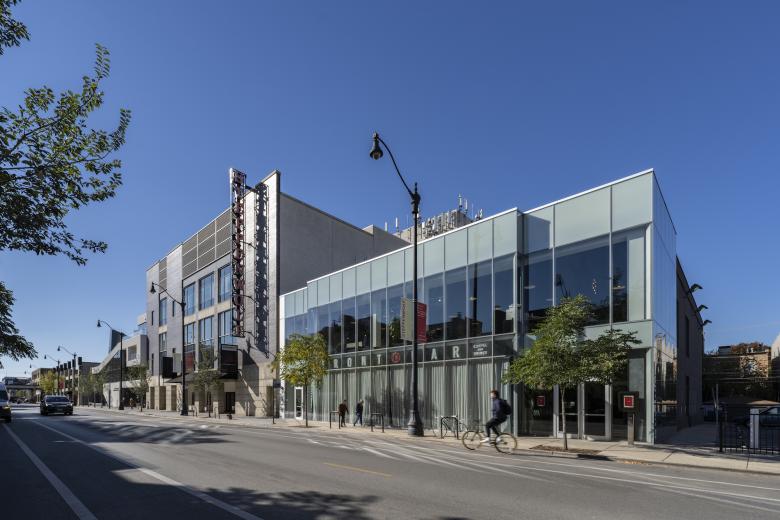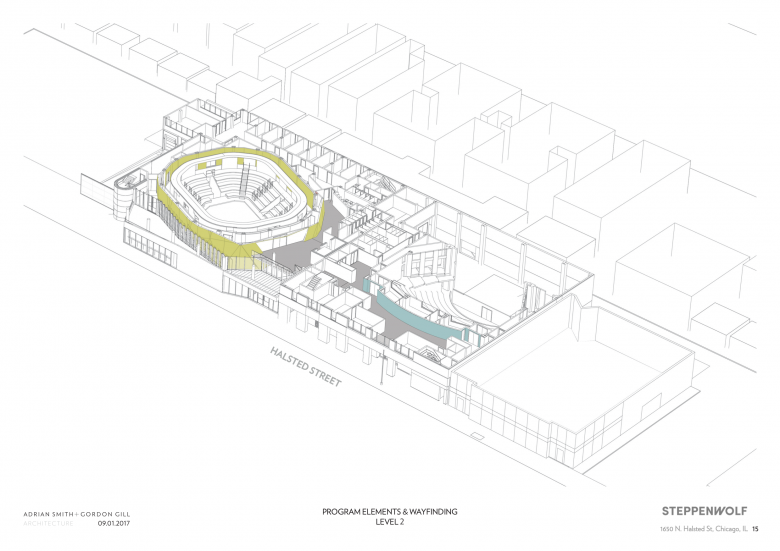US Building of the Week
Steppenwolf Theatre Campus Expansion
After its founding in 1974, the Steppenwolf Theatre Company resided in various locations in Chicago and its suburbs, eventually moving into a permanent home on North Halsted Street in 1991. Thirty years later, in November 2021, the renowned theater company completed a major multi-phase expansion of its campus courtesy of Adrian Smith + Gordon Gill Architecture. AS+GG answered a few questions about the project.
Location: Chicago, Illinois, USA
Client: Steppenwolf Theatre
Architect: Adrian Smith + Gordon Gill Architecture
- Design Principal: Gordon Gill
- Project Architects: Laura Jimenez, Jennie Tolfa, Marc Cerone
- Project Manager: Jonathan Orlove
- Project Team: Jade Boudreaux, Rebecca Cryder, Gail Goldstead, Felix Griggs, Melissa Marrero, Luis Palacio, Griffin Pemberton
MEP/FP Engineer: Environmental Systems Design
Civil Engineer: Spaceco
Landscape Architect: Oslund and Associates
Lighting Designer: Morlights
Interior Designer: Adrian Smith + Gordon Gill Architecture
Contractor: Norcon Inc.
Bar Designer: FC Studio
Signage: Studio Blue
Telecommunications: Client First
Theatre Consultant: Charcoalblue
Fire & Life Safety Consultant: Jensen Hughes
Client Representative: CBRE
Site Area: 18,787 sf
Building Area: 53,000 sf
See below for Important Manufacturers / Products
The project was a direct commission. Steppenwolf had been undertaking a search for an architect to translate their artistic vision and met with Gordon Gill in 2007 at Adrian Smith + Gordon Gill Architecture’s offices in Chicago. Although Gordon’s experience was not focused on theater architecture, he had worked on several cultural projects during his tenure including Ravinia, Avery Fisher Hall, and The Civic Opera House. Steppenwolf was looking for the right fit to realize their vision and had a much broader perspective than the single building. Their vision was to understand their ensemble of buildings and their program as a campus along Halsted Street in Chicago.
After the meeting, where synergistic ideas flowed, AS+GG was hired for the job. That magnetic connection sparked a relationship that would fuel a fourteen-year relationship that spanned work on the overall master plan and the building’s early conversations. The client and design team always working together and returning to the idea of “community” and what it meant for the building. “There was an opportunity for the role of the art and how the art presented itself to the public,” said Gill. “Almost like the soapbox idea in the public square, it wasn't so much a physical concept or an architectural concept as it was a kind of abstract concept of reaching out and bringing the art to the public.” That idea of the “Town Square” evolved over time and was ultimately defined by Artistic Director Anna Shapiro who explained Theater as a “Collision” between an audience and actor. This concept is what drove the final design of the building.
The 50,000 sf Steppenwolf Theatre Expansion includes a new in-the-round theater and education center and is now named the Liz and Eric Lefkofsky Arts and Education Center. The transformed Steppenwolf campus will change the way Chicagoans and visitors experience the company’s cutting-edge theater when in-person performances return in 2022. Steppenwolf’s Liz and Eric Lefkofsky Arts and Education Center is the largest new permanent cultural asset to open in the City of Chicago in 2021. The $54 million building project is part of Steppenwolf’s multi-phase $73 million campus expansion, and includes Steppenwolf’s first-ever dedicated education space, The Loft, encompassing the entire fourth floor of the new building.
The expansion introduces new relationships with its patrons, neighborhood, and Chicago as a whole. Architecturally, the design is carefully stitched into its neighborhood context, recognizing the significance of its presence along Halsted Street, while respecting its neighbors. At the heart of the center is an intimate and state-of-the-art 400-seat theater in the round, one of its kind in Chicago. The concept, based on Collision, that interaction between the actor and the audience serves to establish dynamic and intimate spatial relationships throughout the project. The theater is only six rows deep, always placing the actor in an intimate relationship with the audience. No audience member will be more than 20 feet from the stage, blurring the lines of actor/audience relationships.
Other improvements include a dedicated education floor for the future of Chicago’s youth. Steppenwolf has always had a strong commitment to the social construct and neighborhoods across Chicago. Through its Young Adult Council and Teen Programs, the project took an Education-centric approach to its design by placing the Teens and the future youth of Chicago at the Center of design and in the most prominent spaces.
The program also includes a dynamic lobby space, Steppenwolf’s costume shop and other updated production amenities, as well as a wine bar and a sidewalk lounge, increasing the social gathering spaces where artists and audiences converge.
Key elements of the in-the-round theatre include a modular staging system that allows for designers and directors to control the architecture, adjust the capacity, and explore different stage footprints for a variety of audience relationships. Accessibility was at the forefront of the design, including twenty fully integrated wheelchair accessible locations (versus the six that are required by law), as well as an induction hearing loop and improved sight lines for performances featuring ASL Interpretation and Open Captioning.
The character of the building is heavily influenced by the character of Steppenwolf. The definition of Theater being a “Collision” (that space between the actor and the audience, where theater occurs) was a driving force for our architecture and led to the dynamic nature of the design. The narrative of the materials, concrete structure relating to the history of Steppenwolf and the original Theater, new materials, patterns, and color reacting to the new members of the ensemble; the entire project is conceptually representative of the history and future of Steppenwolf. We hope that the new building also offers a variety of opportunities for Steppenwolf to learn, educate, perform and play; to modify and adapt over time to a range of spaces which were previously unavailable.
Steppenwolf has long had a strong commitment to the social construct and neighborhoods across Chicago. Architecturally, the new theater is carefully stitched into its neighborhood context, recognizing the significance of its presence along Halsted Street, while respecting its neighbors. The former Ethan Allen furniture store directly north of the existing theater was acquired in 2016 as a Phase 1 in the project, which now houses a cabaret theater and a new coffeehouse and bar. At the neighborhood level, it was important that the Lincoln Park theater be transparent in its function and invite participation from the people who live, work, and visit Halsted Street. At the city level, it was important to be inclusive to the diverse, multicultural Chicago communities that Steppenwolf serves. At the individual level, the audience, patrons, staff, and artists, specifically the storied ensemble’s needs be met, as they have driven the theater’s success for thirty years.
The urban design goals for the project took into consideration the context of the extended block as well as the residential neighborhood to the west. The plan considered ideas such as programming of ground floor spaces, to provide cafes for the public, service and accessibility from Halsted Street to relieve the residential alley and creating a massing and architecture that related to the main street as well as to the residents to the west. In doing so the building is quite specific to its context. The main street facade along Halsted was intentionally diverse. Urbanistically, the intent was to maintain the varied street scale and pattern of smaller buildings; never seeking to create a single monolithic expression.
The project intentions remained the same throughout several design iterations. As the client’s needs evolved, so did the design. Originally, the theater was to be a 300-seat theater, with an auditorium that backed into a central courtyard entrance, or Public Square, which also featured an elevated, landscaped terrace with city views. A secondary design included a 400-seat theater with flexible seating configurations and a smaller, 100-seat black box theater.
The project features in the theater design promotes adaptability, flexibility, and inclusivity. Although the new theater is a fixed-format in-the-round room, it was important that the design can adjust to allow for maximum creative flexibility. Without the use of expensive solutions, the theater can be adjusted through a series of demountable platforms that enable alternative configurations, with differing sized stages, entrance locations, and seat numbers.
The main flexible elements are contained in the first two rows, or six feet from the stage edge. A 24-foot section of removable stepped platforming on the long sides can also be reconfigured. This flexible area can be lowered and raised to create a playing space on or below the stage or a platform for a “Juliet balcony” above. The design anticipates that the seating will be frequently reconfigured to provide changing stage shapes and audience sizes within the base format.
The pitch of the seating rake steepens as it ascends, maximizing downward sightlines and maintaining the backstage circulation route beneath. This “cupping” increases the intimate feel of the theater and the feeling of audience density through the space, as it allows a direct connection from actor to audience, even from the back rows.
The maximum stage size is 36’ x 24’, with a base seating capacity of 402, set over six rows. This capacity is determined by three-foot-deep rows and 22-inch seat widths. The rows rise from the stage with the first-row seven inches above stage level and then a rise of 14 inches for the second row and 21 inches for each subsequent row.
The design offers eight wheelchair positions as a base, with two in the first row near the fixed vomitories and six positioned around the space on the rear row. It is possible to add additional spaces around the auditorium if required for alternate formats.
At the third level is a technical walkway around the perimeter providing access to a network of catwalks for suspended technical equipment. Also at this level, is a suite of control rooms that provide enclosed spaces for operation of technical equipment. These two elements provide excellent technical capabilities but also create the feeling of a ceiling, helping to focus the room towards the acting area.
The major interior and exterior materials in building are GFRC, Polished Concrete, Glass, EIFS, Quarter Sawn White Oak and perforated metal. The materials were selected to be honest, humble, durable, and simple and align with the architecture of the building. Wood screen elements and perforated wall and ceilings are used to create a veil effect to reveal the construction behind creating depth and play of light. The idea of interior and exterior surfaces in a state of layering and collision creates unique spatial character. Skylights used around the GFRC enclosure of the theatre; the ‘heart’ and throughout the patron spaces, allow for natural light to activate and invigorate the public spaces.
Email interview conducted by John Hill.
- GFRC Panels: Building Blocks
- Stair Tower Panels: Alucobond
- EIFS: Dryvit
- Glass/Windows: Oldcastle
- Roofing/Waterproofing: Carlisle
- Fire Protection: Carboline
- Insulation: Dow, Owens Corning
- Acoustical Baffles: ACGI
- Acoustical Plaster: Pyrok
- Theatre Seats: Series
- Theatre Wall Panels: 555














